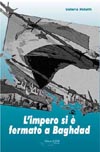February 21, 2007
John Prados is a senior analyst with the National Security Archive in Washington, DC. His current book is Safe for Democracy: The Secret Wars of the CIA. The Polo Step slides can be examined on the National Security Archive website.
The now-infamous Downing Street documents showed how President George Bush managed his move to war by fitting intelligence to his policy, and by refusing to accept the reports of United Nations inspectors who could find no Iraqi weapons of mass destruction. Now there is a new hot document that confirms that Bush and British Prime Minister Tony Blair intended to sucker Saddam into war. It demonstrates that this aim was present long before the Bush-Blair talks, and indeed that provocation formed an integral feature of the U.S. war plan.
A January 31, 2003 meeting between Bush and British Prime Minister Tony Blair clearly shows the two leaders discussing ways to provoke Saddam Hussein so as to justify war, indicating premeditation. Last week the National Security Archive in Washington posted the U. S. war plan—the set of briefing slides used by Central Command (CENTCOM) chief General Tommy Franks to brief President Bush on "Polo Step," CENTCOM’s Iraq invasion scheme. The PowerPoint slides were prepared for a series of presidential meetings held from December 2001 to August 2002. The slides summarized CENTCOM’s buildup and maneuver concepts for Bush’s deliberations. Bush backed Franks’ concept of "adjusting" Iraqi defenses by executing what amounted to a covert offensive air campaign. They would use forces already in the Persian Gulf region for the ostensible purpose of enforcing no-fly zones created after the first Gulf War. TomPaine.com has previously covered this operation ("The War Before the War ," June 24, 2005), but the new evidence establishes an explicit link between the aerial offensive and the Iraq war plans.
The no-fly zones were originally designed to prevent Iraqi government interference with humanitarian efforts in northern Iraq ("Operation Northern Watch") and against Shiite minorities in the southern region of the country ("Operation Southern Watch"). They used aircraft based in Turkey, Saudi Arabia, and on aircraft carriers in the Gulf. Until 2001, it had been standard practice for U.S. and British aircraft participating in these missions to retaliate against Iraqi anti-aircraft guns, missiles, and radars that had fired at the planes. CENTCOM had a plan it called "Desert Badger" that established standard operating procedures for such strikes.
In early 2002, General Franks and his aerial component commanders revised the old arrangement. CENTCOM created a set of "response options" from 1 to 5, providing successively higher levels of violence. The Polo Step briefing slides make clear that U.S. planners envisioned using response options in the case of "triggers,"—Iraqi actions—and specified 16 different possibilities to lead to retaliation These ranged from simple interference with flights to major threats or attacks on friendly regional neighbors. One of the Downing Street documents reveals that the British realized the no-fly zones had no basis in international law and the contemplated air campaign no justification as "self defense." A May 2002 CENTCOM slide noted that "contingency plan execution is tailored to match strategic timing and current strategic environment."
Several additional scales of action were denoted by colors (blue, white, red). Response Option 5 and Level Blue were to be triggered by a "provocative posture" or limited violence and envisioned as small scale warfare. By August 2002, "small scale" activity was defined in the Polo Step briefings as attacks over a 48-hour timeframe on a hundred targets by up to 300 aircraft. The "white" action level, an August briefing slide reveals, would "begin to shape [the] battlefield." Tommy Franks notes in his memoirs that another color level actually became the "running start" war option once CENTCOM planners began calling it that and Defense Secretary Donald Rumsfeld fell in love with the concept.
Southern Watch air attacks resumed in May 2002, coincident with one of the Polo Step briefings, following a six-month period in which there had been virtually no air action. In August, when Franks presented near-final versions of his war plan, Rumsfeld changed the rules of engagement for the air forces and Southern Watch became Southern Focus. Suddenly, in early September, there followed a four-day series of sustained strikes hitting Iraqi military communications, headquarters, anti-ship missile and air defense communications facilities, all considered key targets in "adjusting" Saddam’s defenses. Two-thirds of more than 21,000 attack sorties, or flights counted by single aircraft, that took place before the invasion occurred in the Southern Focus timeframe beginning in August.
The September strikes corresponded to the White level that General Franks described in May and August slides. That was described as an air operation of five to seven days’ duration involving about 1,000 flights by coalition aircraft. This effort was supposed to have been triggered by the shootdown of a U.S. aircraft, an Iraqi link to a terrorist act, or confirmed weapons of mass destruction (WMDs) within Iraq. After that strikes concentrated overwhelmingly upon shaping the battlefield rather than their supposed purpose of countering interference with the no-fly zones. In January 2003, it was reported that there had been almost two attacks on higher echelon Iraqi military targets for every one aimed at air defense or radar sites.
We know from history that Saddam’s air defenses never did destroy an aircraft in the no-fly zones—not even a Predator drone. Nor were there Iraqi terrorist attacks or prewar confirmations of WMDs. Saddam refused to supply the provocation that Bush wanted. Not to be put off, Bush simply dispensed with the triggers and moved ahead on his aerial offensive. When, at the height of the 2004 electoral season, President Bush told reporters that before the war his administration had been dealing only with Desert Badger, he was being disingenuous. This decoupling of the air attacks from any relation to actual Iraqi activity is the smoking gun that makes plain Bush’s aggressive intent. Of course, an actual invasion of Iraq could not be done covertly, and that fact led directly to the Bush-Blair conversation in the Oval Office on January 31, 2003. Some justification for war remained necessary. Bush never got it. The prewar air campaign was purposeful, targeted and premeditated, one more manipulation on the road to tragedy.
















